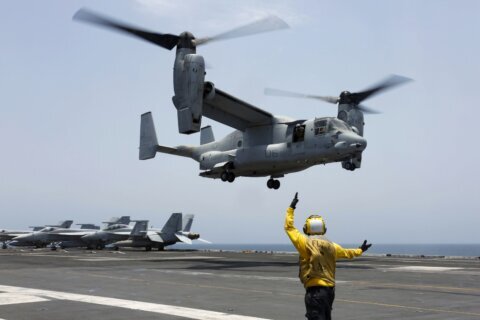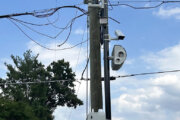WASHINGTON (AP) — The U.S.-built pier to bring food to Gaza is facing one of its most serious challenges yet — its humanitarian partner is deciding if it can safely and ethically keep delivering supplies arriving by the U.S. sea route to starving Palestinians.
The United Nations, the player with the widest reach delivering aid within Gaza, has paused its work with the pier after a June 8 operation by Israeli security forces that rescued four hostages and killed more than 270 Palestinians. Adding to the troubles, two U.S. officials said Friday that the pier would be detached again because of rough seas to prevent it from breaking apart as it did in bad weather last month.
Rushing out a mortally wounded Israeli commando after the raid, Israeli rescuers opted against returning the way they came, across a land border, Rear Adm. Daniel Hagari, an Israeli military spokesman, told reporters. Instead, they sped toward the beach and the site of the U.S. aid hub on Gaza’s coast, he said. An Israeli helicopter touched down near the U.S.-built pier and helped whisk away hostages and the commando, according to the U.S. and Israeli militaries.
For the U.N. and independent humanitarian groups, the event made real one of their main doubts about the U.S. sea route: whether aid workers could cooperate with the U.S. military-backed, Israeli military-secured project without violating core humanitarian principles of neutrality and independence and without risking aid workers becoming seen as U.S. and Israeli allies — and, in turn, targets in their own right.
Israel and the U.S. deny that any aspect of the month-old U.S. pier was used in the Israeli raid. They say an area near it was used to fly home the hostages.
The U.N. World Food Program, which works with the U.S. to transfer aid from the $230 million pier to warehouses and local aid teams for distribution within Gaza, suspended cooperation as it conducts a security review. Aid has been piling up on the beach since.
“You can be damn sure we are going to be very careful about what we assess and what we conclude,” U.N. humanitarian chief Martin Griffiths said.
Griffiths told reporters at an aid conference in Jordan this week that determining that the Israeli raid improperly used either the beach or roads around the pier “would put at risk any future humanitarian engagement in that operation.”
The U.N. has to look at the facts as well as what the Palestinian public and militants believe about any U.S., pier or aid worker involvement in the raid, spokesman Farhan Haq told reporters in New York.
“Humanitarian aid must not be used and must not be perceived as taking any side in a conflict,” Haq said. “The safety of our humanitarian workers depends on all sides and the communities on the ground trusting their impartiality.”
Rumors have swirled on social media, deepening the danger to aid workers, humanitarian groups say.
“Whether or not we’ve seen the pier used for military purposes is almost irrelevant. Because the perception of people in Gaza, civilians and armed groups, is that humanitarian aid has been instrumentalized” by parties in the conflict, said Suze van Meegen, head of operations in Gaza for the Norwegian Refugee Council.
Oxfam International and some other aid organizations said they are waiting for answers from the U.S. government because it’s responsible for the agreements with the U.N. and other humanitarian groups on how the pier and aid deliveries function.
Questions include whether the Israeli helicopters and security forces used what the U.S. had promised aid groups would be a no-go area for the Israeli military around the pier, said Scott Paul, an associate director at Oxfam.
The suspension of deliveries is only one of the problems that have hindered the pier, which President Joe Biden announced in March as an additional way to get aid to Palestinians. The U.S. has said the project was never a solution and have urged Israel to lift restrictions on aid shipments through land crossings as famine looms.
The first aid from the sea route rolled onto shore May 17, and work has been up and down since:
— May 18: Crowds overwhelmed aid trucks coming from the pier, stripping some of the trucks of their cargo. The WFP suspended deliveries from the pier for at least two days while it worked out alternate routes with the U.S. and Israel.
— May 24: A bit more than 1,000 metric tons of aid had been delivered to Gaza from the pier, and the U.S. Agency for International Development later said all of it was distributed within Gaza.
— May 25: High winds and heavy seas damaged the pier and four U.S. Army vessels ran aground, injuring three service members, one critically. Crews towed away part of the floating dock in what became a two-week pause in operations.
— June 8: The U.S. military announced that deliveries resumed off the repaired and reinstalled dock. The Israeli military operation unfolded the same day.
— Sunday: World Food Program chief Cindy McCain announced a “pause” in cooperation with the U.S. pier, citing the previous day’s “incident” and the rocketing of two WFP warehouses that injured a staffer.
— Friday: The pier was being detached later in the day or into Saturday to prevent damage during rough seas and allow the military to reattach it more quickly later, according to two U.S. officials who spoke on condition of anonymity to discuss military planning. The expectation is that the structure would be put back in place by next week, they said.
The pier has brought to Gaza more than 2,500 metric tons (about 5.6 million pounds) of aid, Pentagon spokeswoman Sabrina Singh said. About 1,000 metric tons of that was brought by ship Tuesday and Wednesday — after the WFP pause — and is being stored on the beach awaiting distribution.
“The WFP, of course, is taking the security measures that they need to do, and the reviews that they need to do, in order to feel safe and secure and to operate within Gaza,” Singh said.
Now, the question is whether the U.N. will rejoin the effort.
For aid workers who generally work without weapons or armed guards, and for those they serve, “the best guarantee of our security is the acceptance of communities” that aid workers are neutral, said Paul, the Oxfam official.
Palestinians already harbored deep doubts about the pier given the lead role of the U.S., which sends weapons and other support to its ally Israel, said Yousef Munayyer, a senior fellow at Washington’s Arab Center, an independent organization researching Israeli-Arab issues.
Distrustful Palestinians suffering in the Israel-Hamas war are being asked to take America at its word, and that’s a hard sell, said Munayyer, an American of Palestinian heritage.
“So you know, perception matters a lot,” he said. “And for the people who are literally putting their lives on the line to get humanitarian aid moving around a war zone, perception gets you in danger.”
___
Lederer reported from the United Nations. AP writer Lolita C. Baldor contributed from Washington.
Copyright © 2024 The Associated Press. All rights reserved. This material may not be published, broadcast, written or redistributed.







